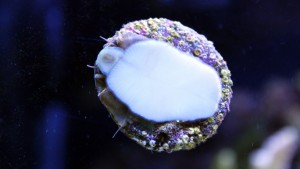Of all the fascinating invertebrates available to marine aquarists, grazing snails are perhaps the most misused. Too often we treat them like expendable little lawnmowers, plopping them in our tanks with the express purpose of preventing or eradicating algae and then replenishing them as their populations inevitably wane. But if treated properly, snails can be long-lived tank denizens that not only perform a useful purpose but also provide interest in their own right.
So what do I mean by “misusing marine snails”? Here are some of the more common improper practices when stocking grazing gastropods:
1) Stocking in excessive numbers
I implore you to ignore any advice along the lines of “To control algae X, add Y number of snails per every Z gallons of aquarium volume.” There is no correlation between the volume of water an aquarium can hold and the number of grazing snails the system can support long term. It all comes down to food supply.
Simply put, the system must contain adequate, ongoing growths of the appropriate algae to sustain the type/number of snails you introduce. Otherwise, your grazing gastropods will quickly eat themselves out of house and home and begin starve to death. It’s always best to start with just a few specimens, observe how they perform when it comes to keeping algae in check, and then add more only if necessary.
2) Stocking cold-water species in tropical tanks
Some marine snails sold to unwitting hobbyists for the purpose of algae control—often as part of a “cleanup crew”—are actually from temperate waters and won’t survive long in tropical aquariums. One such example is Tegula funebralis, which is commonly sold as the “margarita snail” (other snail species are assigned this same moniker as well).
3) Right snail, wrong algae
In other cases, the snail species in question may be well suited to tropical conditions but simply won’t eat the type of algae it was introduced to control. For example, a hobbyist hearing that tropical Lithopoma spp. snails are good algae eaters might add a bunch of them in hopes that they’ll bring an end to, say, a bubble algae outbreak. Trouble is, they can’t eat bubble algae and won’t make so much as a dent in it. Instead, they feed on diatoms and microalgae films. If these aren’t available and no other effort is made to feed them, they may starve to death—especially if stocked in large numbers.
4) Stocking based on a transient algae bloom
Another snail-stocking error hobbyists too often make is adding a number of snails in response to the natural sequence of algae blooms that commonly occurs as a new tank matures. For instance, shortly after a new tank has been set up, it’s typical for a bloom of diatoms to develop, giving all the surfaces in the tank an unsightly brown coating.
Ah, but Lithopoma snails eat diatoms! Drop in a dozen or so and the problem is solved, right? Well, yes and no. True enough, the snails will eat the diatoms, but such blooms in the run-up stage of a new aquarium tend to be self-limiting, so the food supply for all those snails will soon “dry up” leaving them vulnerable to starvation.
5) Failing to provide the right substrate
Another reason it’s important to research grazing snails before buying them is that some have particular needs when it comes to substrate. For instance, certain Cerithium spp. sold in the hobby naturally burrow and feed on detritus and other edibles in the sand and, thus, must be provided a deep sand bed in aquaria. These snails may be included in cleanup crews, and hobbyists buying one of these packages may not be aware of this requirement.
Also, some grazing snails routinely sold in the aquarium trade, e.g., various Turbo spp. and the aforementioned Lithopoma spp. among others, may not be capable of righting themselves if they should tip over on sand. The reason being, they naturally occur on reef flats where they’re always in touch with a hard surface. In aquariums with fine-grained substrates, if these snails do end up getting knocked onto the sand on their side or back, they’ll just lie there—vulnerable to predation by opportunistic tankmates—unless an observant hobbyist picks them up and returns them to the rocks.
Do your homework!
The bottom line is, it’s important to learn all you can about the habits and care requirements of any snail species before buying it, just as you would with fish, corals, or other livestock, and don’t assume that a snail species is appropriate for your system just because a dealer is offering it for sale or it’s packaged as part of a cleanup crew.



